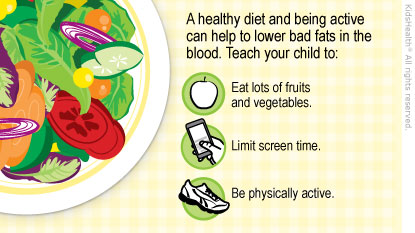Blood tests show that your child has dyslipidemia (dis-lip-id-EE-mee-ah), a condition in which too many bad fats and not enough good fats are in the blood. A healthy diet and regular physical activity can get the fats in better balance. This helps prevent heart disease later in life.




What is dyslipidemia? Dyslipidemia is when someone has unhealthy levels of the lipids (fats) cholesterol and/or triglycerides in their bloodstream. The body needs these fats to make cell membranes and some hormones, and to help store energy. But children who have high levels of cholesterol and triglycerides are more likely to have heart disease when they grow up. Correcting the balance of fats now can prevent these problems.
Dyslipidemia can include any combination of these:
What causes dyslipidemia? Poor diet and an inactive lifestyle can cause dyslipidemia or make it worse. Smoking raises LDL cholesterol and triglycerides and lowers HDL cholesterol. Dyslipidemia also runs in some families. In some kids, certain medical problems (such as hypothyroidism, diabetes, or kidney or liver disease) can cause dyslipidemia.